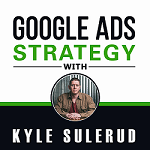Video Transcript
So the next thing to look at in the search term report is the actual data. The first thing we did was, just look down the search term column that we use, basically common sense to find search terms that didn’t match what we were selling and added them as negatives. Now we can look at some more of the columns under right here, and look for any outlying data that might tell us we need to add some more negative keywords. When you first open this report you’re gonna see a different set of columns over here, you can customize this by clicking on columns here – modify columns and have it set up like this, just because it’s the easiest way to show you what I’m looking at. So when we’re looking at the list here, let’s take a look at this top term, “Decorate your own cake.” We see that it’s been added as an exact match terms so we’ve started the campaign with this an actual keyword there were targeting.
We’ve gotten 625 clicks, spent 46 pounds and received one conversion. We can look at the very top here at the, “cost per converted click column.” This is the average cost per converted click for the whole account, and for this particular keyword we’ve spent. 46 pounds just done 1 conversion the average is obviously a lot lower at 9 pounds. So this tells us that, this is actually isn’t a good keyword. I’m not only is it so high above average, but this is a lot more than we can afford to spend on a conversion to be profitable for this company. So even though you started out with this as an exact keyword – thinking that it would be good, it’s pretty clear to see that it’s actually not a good keyword. So this is going to be one that we want to add as a negative keyword.
A quicker way to identify keywords like this that we’re overpaying for is to sort this, “Cost per converted click column”; by clicking it at the top and that’s going to automatically store it from high to low. So we can see the one we just looked at has the highest cost per converted click. The one’s a little lower aren’t quite as obvious. This one here, “plane iced sponge cake”; and we spent 22 pounds on one conversion. In this case you know just one or two more conversions is going to bring this a lot closer to average, so I’d say it’s a little too soon to exclude this just based on this data. We usually want to see a cost per conversion that’s about three times more than average before excluded, because you never know that the next conversion might come from the next click.
Now if we had more conversions — if we had five or ten conversions already and we were still at two or three times the average cost per conversion — then yeah. There’s probably enough data at that point where we want to get rid of that keyword, or reduce the amount we’re bidding on it — or do something to bring that cost down, but when it’s still just one or two conversions in my opinion — it’s it’s okay to let that go for a while longer and see what might come of it. I’ve definitely had the experience where a keyword initially looked like it was going to have a high cost per conversion, but after giving it some more time it accumulated more conversions and ended up being a good keyword.
So that’s how you’ll use this report to find more negative keywords when you’re looking at the conversion data, you want to make sure that date range is set far enough back so that you have enough data to actually look at — usually you’ll set this back to the start of your campaign. If you have a lot of conversions — a lot of activity, you can set a date range that’s smaller and just make sure it goes far enough back where you’ll have usable data. when you’re just looking at the first column you don’t need to set the date range too far back each time, just set it back to the date when you last looked at the data and that way you only have to look at any new search terms that have come up since then.
